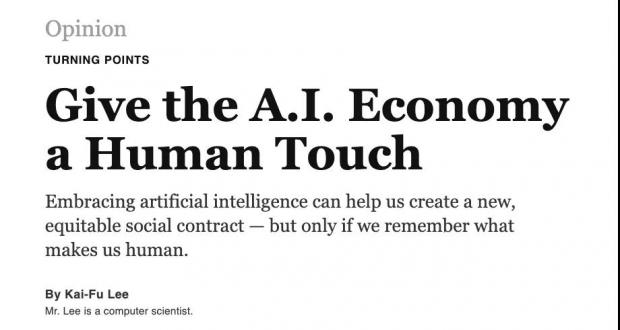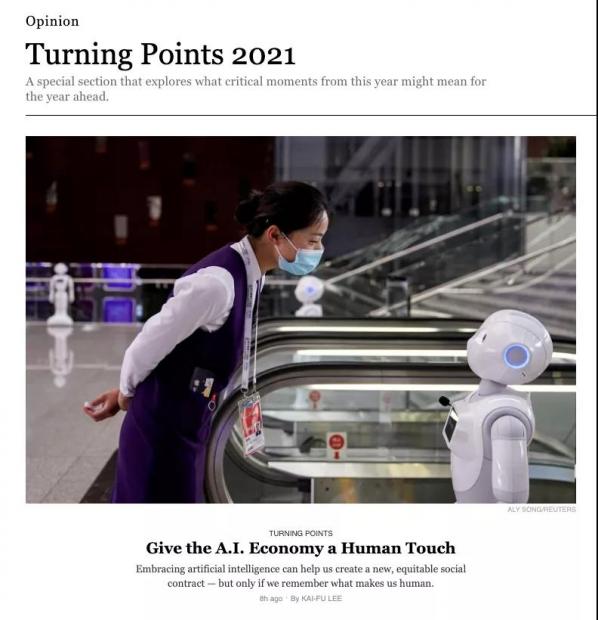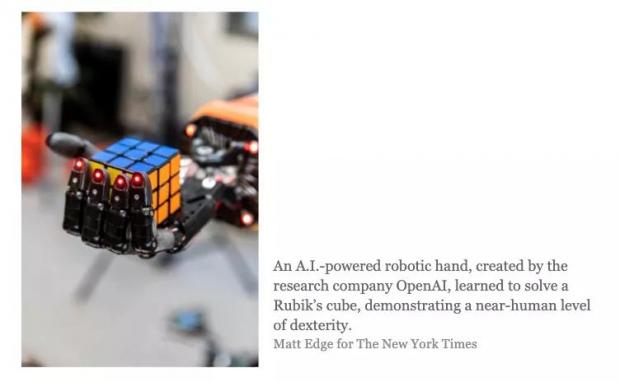阅读:0
听报道
2020全球经历了翻天覆地的变化,或许对大部分的我们来说,都体验了这辈子以来最为严峻的社会性挑战,也让人们放慢脚步、拉高视野,进一步思索个人、社会、全球之间紧密互联的生命共同体意义。
时值年末,《纽约时报 New York Times》推出了 “转折点Turning Point”年度特别策划系列专栏,邀集国际专家共同探讨2020世界变局下的几大关键转折点,以及未来更深远的影响和意义。
我受《纽约时报》邀请撰文,在这篇“Give the A.I. Economy a Human Touch|以人为本,拥抱AI新经济”的文章中,首度提出了AI新经济时代将导致退工潮难题的三种解决方案,在英文简称三个R:Relearn 二次学习,Recalibrate 二次定义,Renaissance 二次复兴。
本篇文章经授权进行编译,原文标题:Give the A.I. Economy a Human Touch

近年来,自动化、机器人与人工智能已经接管了部分常规性、重复性工作。在全球新冠疫情的冲击下,安全保障及降本提效的需求迫切,为自动化取代人工的落地进程起到推波助澜的作用。疫情期间,各行各业都竭力避免人和人直接产生接触,类似餐饮外卖、快递流通、远程医疗都提供了无人接触的新形态服务模式。但疫情趋于稳定后,大多数人仍然迫不及待地重拾和他人碰面开会、热闹聚餐的美好接触。
当人类社会大步迈往AI新经济的同时,2020这一年,我们都上了一堂人性本质的必修课。
我在1983年开启了AI生涯,在当年提交美国卡内基·梅隆大学博士学位的申请书上我写着:“AI是对人类学习历程的阐释,对人类思维过程的量化,对人类行为的澄清,以及对人类智能的理解。AI将是人类认识并理解自己的最后一里。”
某个角度看,当年的我可能错了,但某些方面,22岁的我可能说中了!
AI程序和算法在不少任务上已经能够仿效、甚至超越人脑的表现,如果AI在功能上取代机械式的重复工作,促使人们解放身心去探寻生命的真谛,我们将进一步重拾人类社会独有的情感和人性光芒。
人工智能对重复性工作的冲击已然揭开序幕,和人类雇员相比,AI的本领更强大、成本更低廉。即使某些工作由于短期因素被迫临时取代,长期来说也大概率将一去不复返。人工智能带来巨大经济增长效益的同时,也正掀起前所未有退工潮。我在《AI·未来》一书中预计,到了2033 年,约 40% 的工作将被AI和自动化取代。
AI新经济革命的浪潮已然来临,随之而来的工作消亡问题,是人类命运共同体的时代性挑战。
AI将取代数百万计的工作,AI未来会成为人类的工具甚至同事,在迎接2021年的当下,我提出三种解决方案,在英文简称三个R:Relearn 二次学习,Recalibrate二次定义,Renaissance 二次复兴。

二次学习 Relearn
我们应该发出严正警告,唤醒那些正踩在下岗悬崖边缘的人们,鼓励他们主动出击,重新学习。
令人欣慰的是,有不少人类的技能是AI学不会的,特别是那些需要创造力、社交技巧、复杂工艺、还有仰赖人工操作AI工具的岗位。我们可以逐步帮助人们掌握这些新技能,积极投入“二次学习”,为AI新经济下的新型工作场景做好准备。
职业培训机构需要尽快重设课程,增加AI时代可持续就业的培训科目;政府可为这些培训提供奖励和补贴,企业应当参考类似亚马逊职业选择计划 (Career Choice program) 的方案,为每位时薪制员工花上四年的时间和经费,补贴个人职业再造所需的培训项目,帮助雇员报考如飞机维修技师、电脑辅助设计师、医疗护理师等职业所需的资格许可证。
值得关注的是,随着财富增长与寿命延长,“银发看护”方向的关怀型职业将成为社会刚需,其重要性与需求量都会水涨船高。世界卫生组织预测,要实现联合国“人人享有良好的健康和福祉”的可持续发展目标,全球医护人员需求的缺口高达 1800 万人。过去,这类关怀型职业往往被重视度欠佳、薪酬也普遍偏低,但往后,这些“以人为本”的关怀型职业将成为AI新经济运行的基石,也值得更多人考虑通过二次学习来投入。
为了进一步平衡人力供需失衡,我们甚至可以考虑把目前“志愿者服务”类型的工作调整为全职薪酬工作,诸如献血中心人员、动物保育员、夏令营老师、心理咨询师等。可预见的是,自动化时代一旦到来,社会将需要大批志愿者为失业人员提供热线咨询,辅导人们解决职场转换的疑难杂症,排解心理压力而可能造成的社会问题,这些志愿者也应当获得合理的报酬和认可。
二次定义 Recalibrate
在整体社会迈向AI新经济的转型期,有不少职业需要重新定义具体的工作内容和工作方式。
我们都经历了信息化革命,短短几十年内彻底改变了人们的工作方式。AI时代则进一步催生各行各业的智能化进化解决方案:AI能海量计算量化任务的最优解,AI能测算不同条件下的沙盘推演, AI能协助不同行业的岗位优化流程,代劳日常重复事务。我认为,很难有单一通用型的AI工具。AI必须针对各个行业提供高定制化的解决方案,举凡药物分子研发、营销广告策划、新闻信息核实等任务,都能通过定制的AI工具来实现。
当我们采用“二次定义”的方案,充分把以人为本的人性特质,和AI善于优化的技术优势深度结合起来,许多工作职业将被重塑,不少新兴岗位也将随之而来。
AI和人类各展所长、分工协作,AI能既智能又敏捷地承担起各种重复性任务,从业者的时间就能花在需要温暖、创意、策略的人文层面工作,发挥1+1> 2的纵效。举例来说,人们生病了仍然最为信任人类医生,医师用着专业AI医疗诊断工具,快速准确地为患者计算出最佳的治疗方案,于是能匀出更充裕的时间和病人深入探讨病情,抚慰他们的心灵。医生的职业角色将会二次定义为“关爱型医生”。
正如移动互联网催生了滴滴司机、美团小哥等职业,AI的崛起也将创造出渐显雏形的新工作。目前已经有AI工程师、数据科学家、数据标注员、机器人维修员等AI时代的新职业,我们应时刻关注AI新经济进程中涌现出的新兴岗位,确保就业大众掌握情况,辅以培训。

二次复兴 Renaissance
中国历史上有脍炙人口的唐诗宋词元曲;滥觞于意大利的欧洲文艺复兴则诞生了辉煌的文学、音乐、建筑和雕塑,数百年后仍为人赞颂(译注:Renaissance一词即为文艺复兴)。AI新经济将能激荡出怎样的人文复兴?值得我们引颈以待。
AI新经济时代将改写职场规划的固有模式。人工智能与自动化技术为人类代劳了重复性事务,我们得以重新检视传统意义的工作形态,我们工作与生活两者将如何重新平衡?我们每周的工作时间表是不是能更加个性化?如今的退休等同于个人生产力终止,但往后是不是能开展截然不同的第二人生?
AI新经济时代将促成一套全新的社会契约。AI将人类从重复工作释放出来,我们的时间宽裕了,我们的心志解放了,人们终于能够专注于最擅长的领域,释放激情、创造力及才华,把我们的能力用于发明、发现、创造、创意等层面,人人都有机会通过AI时代的二次复兴,重新发掘内在的真实潜力。
AI工具将成为绘画、雕塑及摄影艺术家们的得力助手,AI视觉工具可以按照他们的指示来构建、实验、完善作品。AI文字工具得以辅助小说家、诗人、记者为写作注入新灵感。教师花在批改试卷和作业的任务交给AI,时间精力节约出来,得以设计崭新的课程课件,激发学生的好奇心、批判性思维和创造力。课堂间传递标准化知识信息的任务交给AI,时间交给老师和学生们进行个性化互动、启迪孩子们的情商,老师们才能蜕变为AI时代的教育家。
缔结新的社会契约
针对人类社会即将迎来前所未有的退工潮挑战,上述三种解决方案的框架是当务之急。不仅用人单位需要对大量失业人员再培训,政府及有关单位需要提前规划大笔经费来支撑这个过渡阶段,学校需要及早检视课程体系,培养具备创造性、社交技能和跨领域知识的未来人才。我们需要重新定义职业道德、社会身份、企业责任及政府角色等概念,需要接纳更多元化的工作生活平衡理念。简而言之,我们必须通过AI来彻底改造社会,缔结新的社会契约。
在上述各个方面,人工智能技术在里面的角色都至关重要。如果我们运用集体智慧,人工智能就可让人们释放天性与创造力。
期待我们本着以人为本的精神,拥抱AI新经济。
作者:创新工场董事长兼CEO 李开复博士 – 计算机科学家、企业家、作者
本文经《纽约时报》授权进行中文编译,原文如下:
Give the A.I. Economy a Human Touch
Embracing artificial intelligence can help us create a new, equitable social contract — but only if we remember what makes us human.
By Kai-Fu Lee
Mr. Lee is a computer scientist.
Dec. 10, 2020, 1:00 p.m. ET
This is an article from Turning Points, a special section that explores what critical moments from this year might mean for the year ahead.
Turning Point: The coronavirus pandemic inspired a wave of touchless, contactless interactions — including food delivery and medical care — and the replacement of human workers by computers and other technology.
Automation, robotics and artificial intelligence technologies have been taking over routine tasks for years. The Covid-19 pandemic has rapidly increased that trend, driven by the triple necessities of increased productivity, lower costs and human safety. Suddenly, human contact is both undesirable and more longed for than ever. Delivery companies, plumbers and even some medical providers now boast about their “zero contact” service, but we relish any chance we get to have an in-person meal or a face-to-face meeting.
As we face the future of an A.I. economy, 2020 has taught us the importance of human connection.
When I began my career in A.I. in 1983, I described A.I. in my application to the Ph.D. program at Carnegie Mellon University as “the quantification of the human thinking process, the explication of human behavior” and our “final step” to understanding ourselves.
In a way I was wrong, and in a way I was right. A.I. programs are capable of mimicking and even surpassing human brains in many tasks. But if A.I. allows us to truly understand ourselves, it will be because it liberates us from the mechanical drudgery of routine tasks and allows us to focus on our humanity and the compassionate connections between us.
We already know that many of the jobs that are being replaced will not return, because A.I. can do them much better than people at essentially zero cost. This will generate tremendous economic value but will also result in unprecedented job displacement. In my book “A.I. Superpowers: China, Silicon Valley, and the New World Order,” I estimated that by 2033 A.I. and automation will be able to do 40 to 50 percent of our jobs.
To prepare now for the millions of displaced jobs and tackle retraining for the new skills required when A.I. is both a co-worker and a tool, I propose the 3 R’s — relearn, recalibrate and renaissance — as part of a gargantuan reimagination of how we live and work to deal with the central economic issue of our time: the A.I. revolution.
First, and perhaps easiest, is forewarning people in endangered jobs and establishing programs for them to relearn their fields in the context of A.I. The good news is that there are plenty of “human” skills that A.I. cannot master: creativity, social interaction, physically complex or dexterous work and, of course, using the A.I. tools that require human operators.
Vocational schools need to redesign their curriculums to increase courses for sustainable jobs. Governments could take the lead and provide incentives and subsidies for those courses, rather than blindly pursuing broad-brush economic measures like universal basic income. Corporations could also provide programs, such as Amazon’s Career Choice program. This program pays up to $12,000 annually over four years for Amazon’s hourly employees to earn degrees in high-demand occupations such as aircraft mechanics, computer-aided design and nursing.
Pandemic or no pandemic, the importance and number of human-centric service jobs, such as nursing, will grow as wealth and life spans increase. The World Health Organization predicts that by 2030, we will fall short of the number of health care workers required to achieve the United Nations Sustainable Development Goal of “good health and well-being for all” by approximately 18 million. There is an acute need to reassess such vital, yet undervalued, human-centric service roles both in terms of how they are perceived and how much they are paid. These jobs will form a bedrock for the new A.I. economy.
As we prepare people for the eventual transition to an A.I.-driven economy, we will also need to recalibrate many of today’s jobs. Like software did a few decades ago, A.I. can augment humans’ creative thinking with a computer’s relentless ability to churn through masses of data, hypothesize alternatives or optimize outcomes. There will not be a single, generic A.I. tool, but specific tools customized for each profession and application. We may have an A.I.-based molecule generation program for drug researchers, an A.I. advertising planner for marketers or an A.I. fact checker for journalists.
Merging A.I. optimization and the human touch will reinvent many jobs and create even more. A.I. will take care of routine tasks in tandem with humans, who will carry out the tasks that require, well, humanity. For example, future doctors will still be a patient’s primary point of contact, but they will rely on A.I. diagnostic tools to determine the best treatment. This will redirect the doctor’s role into that of a compassionate caregiver, giving them more time with their patients.
Just as the mobile internet led to roles like the Uber driver, the coming of A.I. will create jobs we cannot even conceive of yet. Examples today include A.I. engineers, data scientists, data-labelers and robot mechanics. We should watch for the emergence of such roles, make people aware of them and provide training for them.
Finally, just as the wealthy Italian cities and merchants funded that country’s Renaissance, we must hope that A.I. will inspire a renaissance of its own. With machines taking over many duties and tasks in the new economy, A.I.will inject flexibility into traditional working patterns, allowing us to rethink what work-life balance should look like and transforming both the weekday routine and retirement thresholds. With more freedom and time in such a new social contract, people will be liberated to follow their passions, creativity and talents, and to let that personal exploration inform their careers as never before.
Painters, sculptors and photographers will be able to use A.I. tools to compose, experiment, enumerate and refine their artwork. Novelists, journalists and poets will use new technologies to take their writing in previously unthought-of directions. Educators, freed from the drudgery of grading and paperwork, can finally unleash their energy to design lessons that encourage curiosity, critical thinking and creativity. A.I. programs can help teach facts and figures so that teachers can spend more time developing students’ emotional intelligence.
The three R’s will represent an unparalleled undertaking for humanity. Companies will need to retrain a massive number of displaced workers. Governments must raise an astronomical amount of money and redistribute it to fund this transition. Schools need to reinvent education to produce creative, social and multidisciplinary graduates. Everything must be redefined: the work ethic of society, entitlements for citizens, responsibilities for corporations and the role of governments.
In all of this, the role of A.I. technologies is crucial. If we do it right, A.I. will free us to embrace not only our creativity and compassion for one another, but also our humanity.
纽约时报官网原文链接:
话题:
0
推荐
财新博客版权声明:财新博客所发布文章及图片之版权属博主本人及/或相关权利人所有,未经博主及/或相关权利人单独授权,任何网站、平面媒体不得予以转载。财新网对相关媒体的网站信息内容转载授权并不包括财新博客的文章及图片。博客文章均为作者个人观点,不代表财新网的立场和观点。




 京公网安备 11010502034662号
京公网安备 11010502034662号 